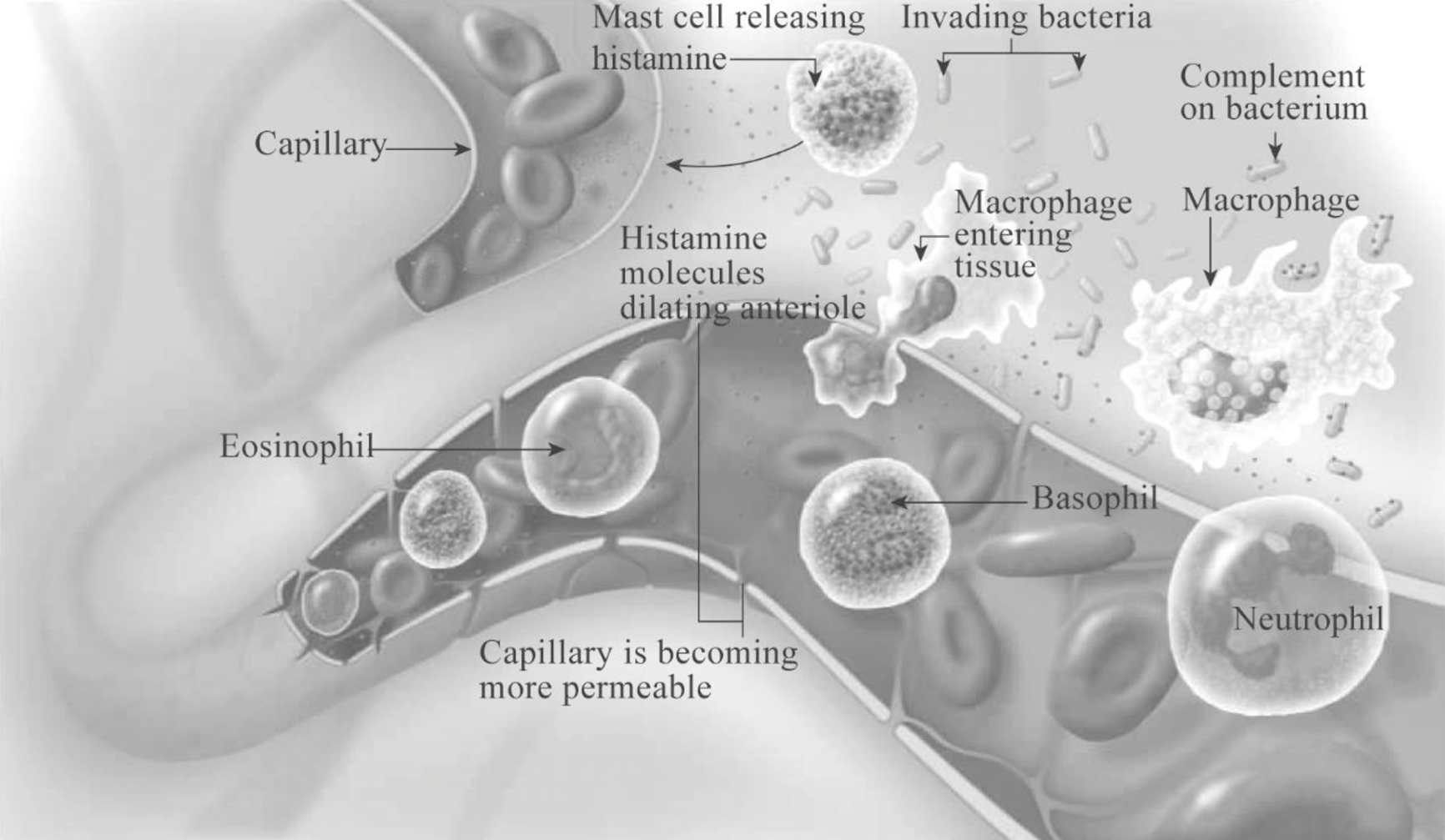
To describe: The signs of inflammation that came in the given statement.
Introduction: An inflammation is the sequence of events in response to the infections that would limit the effects of injury or any agent in the body. It is the biological response against the harmful stimuli to eliminate the initial cause of the healthy tissue injury or damage. Its main function is to act as a defense mechanism of the body to remove the injurious agents from the body to prevent infections.
Explanation of Solution
Given statement: While jogging in the surf, a person’s toes land on a jelly fish. The bottom of the toes becomes swollen, red, and warm to touch.
In the given case, the sting of the jellyfish causes inflammation that accompanies the visible signs such as redness, swelling, warmth, and pain. The inflammation begins through a signal provided by the damage caused by the sting. The basic steps involved in the inflammation are caused by the sting of jelly fish as follows:
Basic steps involved:
- 1. Release of various chemicals: Numerous chemicals such as histamine, interleukins, tumor necrosis factors (TNFs), chemotactic factors, leukotriene, and prostaglandins are released by the damaged cells of injured tissues basophils, mast cells, macrophages, dendritic cells, and infectious organisms to promote inflammation.
- 2. Vascular changes: The released chemical causes many local effects on the blood vessels such as:
- Increased vascular permeability
- Arteriolar vasodilation
- Leukocyte adhesion
- 3. Leukocyte recruitment:The movement of the leukocyte through the blood at the site of infection occurs by the following processes:
- a) Margination: The cell adhesion molecules (CAM) present on the surface of the leukocytes (first neutrophil and then macrophages) adhere to the endothelial capillaries present within the injured tissue.
- b) Diapedesis: Here, the cells migrate to the site of infection by exiting the blood through “squeezing out” between the vessel walls.
- c)
Chemotaxis : Chemotaxis is the movement of cells along a chemical gradient formed due to the chemicals release by the damaged cells, dead cells, or invading pathogens. Cytokines and granulocyte-macrophage colony-stimulating factor (GM-CSF) are released to attract more macrophages to the site of infection. IL-1 released by macrophages induces fever in the body. - d) Delivery of plasma proteins: Several plasma proteins such as immunoglobulin’s complement, clotting proteins, and kinins are brought into the infection site that cause local effects such as increased vascular permeability, pain, heat, and swelling on the infected site.
- 4. Tissue repair and healing:Immune cells and their secretions process the pathogen and the newly formed lymph carries the pathogen with the unwanted dead cells and cell debris from the interstitial space of the tissue. The exudate (fluid and cellular/protein mix) is passed through the lymph nodes for monitoring, transported liver, and then, removed from the body.
- 1. Redness: Inflammation increases the vascular permeability which causes the flow of a large amount of blood toward the site of infection. Due to the increased blood flow, there will be redness at the site of infection.
- 2. Heat: The heat will be generated at the site of infection due to the increased blood flow as well as the increased
metabolic activity of cells within the area. - 3. Swelling: As a result of inflammation, a large amount of fluid is lost from capillaries into the interstitial space that causes swelling around the injured site.
- 4. Pain: Pain occurs when the pain receptors are stimulated due to the compression from the accumulation of interstitial fluid and by the irritation of the released microbial substances, kinins, or prostaglandins.
- 5. Loss of function: Loss of function occurs due to the pain and swelling.
The cardinal signs of inflammation are as follows:
Thus, several immune factors produced as a result of inflammation neutralize the toxin from the jellyfish.
Pictorial representation: Fig.1 shows the steps in the inflammatory response followed by bacterial invasion and activation of immune cells at the site of injury.

Fig.1: Basic steps in inflammatory response
Want to see more full solutions like this?
Chapter 9 Solutions
Human Biology (MindTap Course List)
- You have identified a new species of a Gram-positive bacteria. You would like to screen their genome for all proteins that are covalently linked to the cell wall. You have annotated the genome, so that you identified all the promoters, operons, and genes sequences within the operons. Using these features, what would you screen for to identify a set of candidates for proteins covalently linked to the bacterial cell wall.arrow_forwardBelow is a diagram from a genomic locus of a bacterial genome. Each arrow represents a coding region, and the arrowheads indicate its orientation in the genome. The numbers are randomly assigned. Draw the following features on the diagram, and explain your rationale for each feature: 10 12 合會會會會長 6 a) Expected transcriptions, based on known properties of bacterial genes and operons. How many proteins are encoded in each of the transcripts? b) Location of promoters (include rationale) c) Location of transcriptional terminators (include rationale) d) Locations of Shine-Dalgarno sequences (include rationale)arrow_forwardSample excuse letter in school class for the reasons of headaches and dysmenorrhea caused by menstrual cyclearrow_forward
- How do the muscles on the foot work to balance on an ice skate, specifically the triangle of balance and how does it change when balancing on an ice skate? (Refer to anatomy, be specific)arrow_forwardWhich of the following is NOT an example of passive immunization? A. Administration of tetanus toxoid B. Administration of hepatitis B immunoglobulin C. Administration of rabies immunoglobulin D. Transfer of antibodies via plasma therapyarrow_forwardTranscription and Translation 1. What is the main function of transcription and translation? (2 marks) 2. How is transcription different in eukaryotic and prokaryotic cells? (2 marks) 3. Explain the difference between pre-mRNA and post-transcript mRNA. (2 marks) 4. What is the function of the following: (4 marks) i. the cap ii. spliceosome iii. Poly A tail iv. termination sequence 5. What are advantages to the wobble feature of the genetic code? (2 marks) 6. Explain the difference between the: (3 marks) i. A site & P site ii. codon & anticodon iii. gene expression and gene regulation 7. Explain how the stop codon allows for termination. (1 mark) 8. In your own words, summarize the process of translation. (2 marks)arrow_forward
- In this activity you will research performance enhancers that affect the endocrine system or nervous system. You will submit a 1 page paper on one performance enhancer of your choice. Be sure to include: the specific reason for use the alleged results on improving performance how it works how it affect homeostasis and improves performance any side-effects of this substancearrow_forwardNeurons and Reflexes 1. Describe the function of the: a) dendrite b) axon c) cell body d) myelin sheath e) nodes of Ranvier f) Schwann cells g) motor neuron, interneuron and sensory neuron 2. List some simple reflexes. Explain why babies are born with simple reflexes. What are they and why are they necessary. 3. Explain why you only feel pain after a few seconds when you touch something very hot but you have already pulled your hand away. 4. What part of the brain receives sensory information? What part of the brain directs you to move your hand away? 5. In your own words describe how the axon fires.arrow_forwardMutations Here is your template DNA strand: CTT TTA TAG TAG ATA CCA CAA AGG 1. Write out the complementary mRNA that matches the DNA above. 2. Write the anticodons and the amino acid sequence. 3. Change the nucleotide in position #15 to C. 4. What type of mutation is this? 5. Repeat steps 1 & 2. 6. How has this change affected the amino acid sequence? 7. Now remove nucleotides 13 through 15. 8. Repeat steps 1 & 2. 9. What type of mutation is this? 0. Do all mutations result in a change in the amino acid sequence? 1. Are all mutations considered bad? 2. The above sequence codes for a genetic disorder called cystic fibrosis (CF). 3. When A is changed to G in position #15, the person does not have CF. When T is changed to C in position #14, the person has the disorder. How could this have originated?arrow_forward
- hoose a scientist(s) and research their contribution to our derstanding of DNA structure or replication. Write a one page port and include: their research where they studied and the time period in which they worked their experiments and results the contribution to our understanding of DNA cientists Watson & Crickarrow_forwardhoose a scientist(s) and research their contribution to our derstanding of DNA structure or replication. Write a one page port and include: their research where they studied and the time period in which they worked their experiments and results the contribution to our understanding of DNA cientists Watson & Crickarrow_forward7. Aerobic respiration of a protein that breaks down into 12 molecules of malic acid. Assume there is no other carbon source and no acetyl-CoA. NADH FADH2 OP ATP SLP ATP Total ATP Show your work using dimensional analysis here: 3arrow_forward
 Human Biology (MindTap Course List)BiologyISBN:9781305112100Author:Cecie Starr, Beverly McMillanPublisher:Cengage Learning
Human Biology (MindTap Course List)BiologyISBN:9781305112100Author:Cecie Starr, Beverly McMillanPublisher:Cengage Learning Human Heredity: Principles and Issues (MindTap Co...BiologyISBN:9781305251052Author:Michael CummingsPublisher:Cengage Learning
Human Heredity: Principles and Issues (MindTap Co...BiologyISBN:9781305251052Author:Michael CummingsPublisher:Cengage Learning Biology (MindTap Course List)BiologyISBN:9781337392938Author:Eldra Solomon, Charles Martin, Diana W. Martin, Linda R. BergPublisher:Cengage Learning
Biology (MindTap Course List)BiologyISBN:9781337392938Author:Eldra Solomon, Charles Martin, Diana W. Martin, Linda R. BergPublisher:Cengage Learning Human Physiology: From Cells to Systems (MindTap ...BiologyISBN:9781285866932Author:Lauralee SherwoodPublisher:Cengage Learning
Human Physiology: From Cells to Systems (MindTap ...BiologyISBN:9781285866932Author:Lauralee SherwoodPublisher:Cengage Learning Anatomy & PhysiologyBiologyISBN:9781938168130Author:Kelly A. Young, James A. Wise, Peter DeSaix, Dean H. Kruse, Brandon Poe, Eddie Johnson, Jody E. Johnson, Oksana Korol, J. Gordon Betts, Mark WomblePublisher:OpenStax College
Anatomy & PhysiologyBiologyISBN:9781938168130Author:Kelly A. Young, James A. Wise, Peter DeSaix, Dean H. Kruse, Brandon Poe, Eddie Johnson, Jody E. Johnson, Oksana Korol, J. Gordon Betts, Mark WomblePublisher:OpenStax College Concepts of BiologyBiologyISBN:9781938168116Author:Samantha Fowler, Rebecca Roush, James WisePublisher:OpenStax College
Concepts of BiologyBiologyISBN:9781938168116Author:Samantha Fowler, Rebecca Roush, James WisePublisher:OpenStax College





